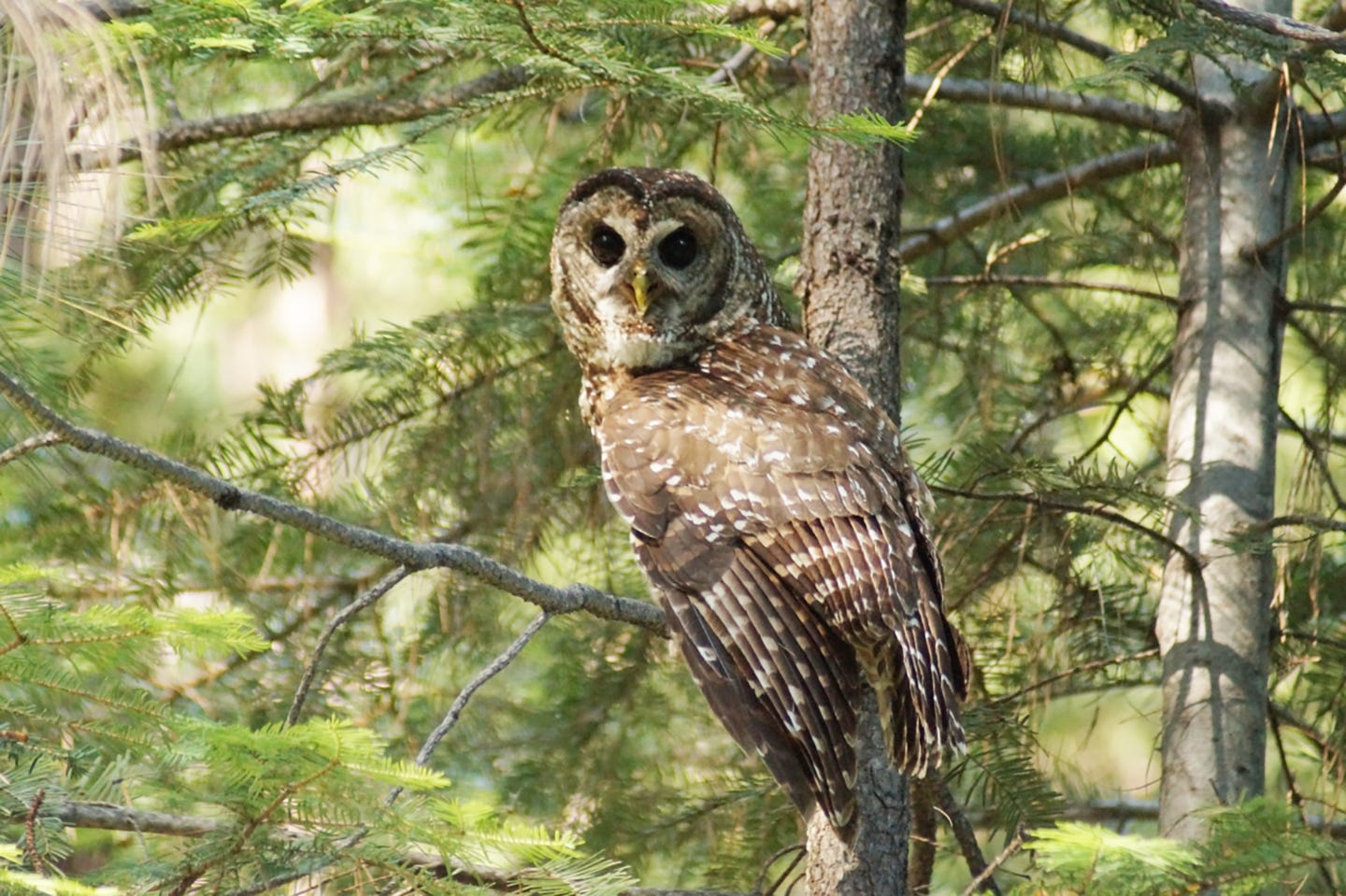U.S. Fish and Wildlife Service seeks comment on California spotted owl proposed listings.
Public comment due by April 24, 2023

U.S. Fish and Wildlife Service seeks comment on California spotted owl proposed listings.
IN LATE FEBRUARY, the U.S. Fish and Wildlife Service announced its determination that the California spotted owl is comprised of two geographically and genetically distinct population segments (DPS). The agency is proposing to list the Coastal-Southern California DPS as endangered and the Sierra Nevada DPS as threatened under the Endangered Species Act.
What that might mean is that the owls would gain greater “protection” under the law.
The management plan for Giant Sequoia National Monument and plans that guide or direct the management of other giant sequoia lands already addressed the California spotted owl and I wondered what impact the proposed listing of the Sierra Nevada distinct population would have, particularly with the thinning and burning projects planned by many land stewards.
I reached out to the U.S. Fish and Wildlife Service, and Meghan Snow, public affairs officer in the Sacramento Fish and Wildlife Office, provided more information in response to my questions:
Question: Does the California spotted owl receive interim protections when it has been proposed for listing?
The California spotted owl will receive the full protections provided by the Endangered Species Act only if the proposed rule is finalized.
However, efforts are already underway to support the owl. Currently, the majority of the range of the Sierra Nevada DPS falls within lands managed by the USFS and Sierra Pacific Industries. Both entities have plans in place that support the conservation of the California spotted owl. These plans contain measures that reduce the risk of large-scale high-severity wildfire – one of the largest threats to the owl—on their lands, while also taking steps that support the owl, such as avoiding work in active nesting areas and maintaining habitat features that the species requires for successful nesting and foraging.
Federal agencies also have the discretion to voluntarily “conference” with the service during a proposed rule for any projects or actions that may affect the species to ensure the project adequately protects the species. The conference opinion is similar to a consultation that would be required once a species become listed, and often can meet consultation requirements should the species be listed.
Question: What does the 4(d) rule in this proposed listing rule for the California spotted owl mean? Does it protect the species during wildfires? Does it enable firefighters to do their work?
This proposed listing is not intended to interfere with essential activities that reduce the risk of large-scale high-severity wildfire and protect local communities, such as reducing forest fuels or maintaining fire breaks.
The service supports land management activities that contribute to healthy forest ecosystems and reduce the risk of large-scale high-severity wildfire.
The large-scale, high-severity wildfires that have been sweeping across California in recent years are bad for the forest ecosystems and bad for our communities, too.
A 4(d) rule is sometimes added to a species that is proposed to be listed under the ESA as threatened. A 4(d) rule tailors protections for the threatened species to prevent further decline and facilitate actions that will assist in a species’ recovery.
For the Sierra Nevada DPS of California spotted owl, the service proposed a 4(d) rule that provides exceptions to the prohibition of take under the ESA incidental to forest fuels management activities that reduce the risk of large-scale, high-severity wildfire.
Stated more simply, if the owl is listed as a threatened species in the Sierra Nevada, the Service will still consult with federal agencies on projects they conduct within CSO habitat. If those projects are focused on reducing forest fuels, maintaining fire breaks, conducting prescribed burns, or other activities that reduce the risk of large-scale, high-severity wildfire, which may still affect the species, a 4(d) rule may streamline the consultation process and affect how the incidental take statement (ITS) is constructed. “Take” is a broad term that ranges from disturbing nesting owls, to injury, to death.
Additionally, during times of active fire, the Service provides emergency consultations to federal agencies, which are performed quickly and put public safety first. When emergency actions are required that may affect listed species and/or critical habitats, a Federal action agency may not have the time for the administrative work required by the consultation regulations under non-emergency conditions. Emergency consultation procedures allow Federal action agencies to coordinate with the Service and incorporate endangered species concerns into their actions during the response to an emergency. Some emergency consultations can occur in an expedited fashion without delaying the emergency response.
A 60-day public comment period on proposed listing ends April 24, 2023. The proposal and information on how to submit comments can be found on www.regulations.gov by searching under docket number FWS-R8-ES-2022-0166.



